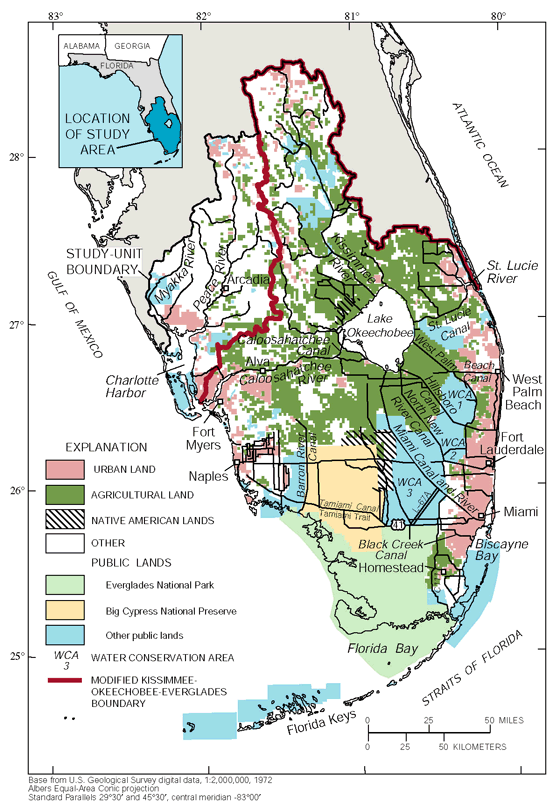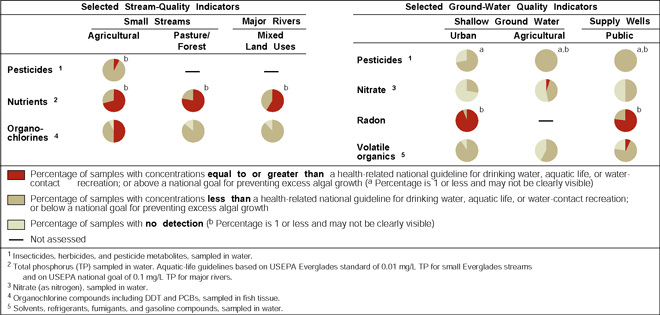SUMMARY OF MAJOR FINDINGS
The environment in southern Florida is being degraded by human activities. Native biota have been reduced greatly in abundance and diversity by drainage, development, alteration of water flows, degradation of water quality, and by continuing invasions of exotic species.The Everglades ecosystem, which is adapted to water that has an extremely low phosphorus concentration, is being altered by agricultural activities that produce high levels of phosphorus in water. Nutrient loading in the major rivers is contributing to overenrichment of Lake Okeechobee and estuaries such as Charlotte Harbor. Mercury has accumulated in Everglades game fish, and consumption of the fish poses a potential human health risk. Mercury has accumulated in the Everglades food web because natural conditions and human influences enhance methylation of mercury to its organic form and because high atmospheric mercury deposition rates (among the highest in the Nation) sustain mercury methylation.
Federal and State agencies and environmental groups agree that parts of southern Florida should be restored to predevelopment conditions. Restoration will require massive changes in the water-management system to restore pre-development drainage patterns, improve water quality, and protect native biota.
 |
| Urban, agricultural, Native American, public lands and other important features in the Southern Florida NAWQA Study Unit (McPherson and Halley, 1996). |
Major findings on water quality and biology from this study:
- Concentrations of total phosphorus (TP) at the Southern Florida (SOFL) National Water- Quality Assessment (NAWQA) Program sites were above Everglades background levels and exceeded the U.S. Environmental Protection Agency’s (USEPA) Everglades water-quality standard of 0.01 milligram per liter (mg/L). A major source of the high TP is fertilizer from agriculture.
- Concentrations of dissolved organic carbon (DOC) in southern Florida water were relatively high compared with those in other waters of the Nation. High DOC concentrations provide food for bacteria to grow, reduce light penetration in the water, and enhance transport and cycling of pesticides and trace elements such as mercury.
- Pesticides were detected in almost all SOFL samples. Most concentrations were below aquatic-life criteria; however, the criteria do not address potential effects of mixtures of pesticides and their degradation products, which were common in the samples.
- Organochlorine pesticides, such as DDT and its degradation products, are still prevalent in bottom sediment and fish tissue at the SOFL sites, even though most uses of these compounds have been discontinued in recent decades. The mobilization of these pesticides by the reflooding of Everglades farm lands could lead to food-web contamination.
- Of 21 NAWQA basins nationwide, the Everglades has the second highest ratio of methylmercury to mercury in sediment.This enrichment in methyl-mercury enhances mercury uptake by the biota.
- The frequency of external anomalies (lesions, ulcers, and tumors) on fish collected at two SOFL agricultural canal sites was in the top 25 percent of 144 NAWQA sites sampled nationwide. Anomalies can be indications that fish are stressed by contamination.
- Exotic animals and plants are a threat to native biota. Ten of the 54 exotic fish species established in the region were collected at the SOFL sites. Several herbicides used to control exotic plants were detected in surface water.
| Major Influences on Surface Water and Ecology
|
In much of the SOFL region, ground water in the surficial aquifers, such as the Biscayne aquifer, is of good quality and usually meets Federal and State drinking-water quality standards. Contaminants are usually in low concentrations, presumably because of rapid flushing and recharge as a result of high annual rainfall (about 55 inches) and shallow aquifers and porous limestone that allow the easy interchange of surface and ground water. However, because of the shallow aquifers and porous limestone, ground water is vulnerable to surface contamination and to saltwater intrusion.
Major findings on ground-water quality from this study include the following:
- Nitrate concentrations were below the drinking-water standard (10 mg/L) in 108 SOFL wells (Biscayne and other surfical aquifers), except for two shallow wells in the unnamed surficial aquifer of the citrus area.
- Pesticides were detected in more than 85 percent of the SOFL wells and beneath every type of land use studied, but no concentrations exceeded any USEPA or State of Florida drinking-water standard.
- Pesticides detected in shallow ground water were associated with specific land uses. For example, the herbicides bromacil and norflurazon were detected almost exclusively in citrus areas. Metolachlor and simazine were common in mixed agricultural areas near the southern Everglades.
- Volatile organic carbon compounds (VOCs) commonly were detected in water from shallow and deep wells in the Biscayne aquifer. Concentrations of one industrial VOC, vinyl chloride, exceeded the USEPA maximum contaminant level (MCL) of 2 micrograms per liter (µg/L) for drinking water in two samples.
- Radon-222 radioactivity exceeded the proposed MCL (300 picocuries per liter ([pCi/L]) in the majority of samples from the Biscayne aquifer, including untreated water from the public-supply wells.
| Major Influences on Ground Water
|
 |
| Table of Contents || Previous Section || Next Section || Glossary U.S. Geological Survey Circular 1207 Suggested citation:
|

